
Minangkabau people, also known as Minang, are an Austronesian ethnic group native to the Minangkabau Highlands of West Sumatra, Indonesia. The Minangkabau's West Sumatera homelands was the seat of the Pagaruyung Kingdom, believed by early historians to have been the cradle of the Malay race, and the location of the Padri War.

Malay houses refer to the vernacular dwellings of the Malays, an ethno-linguistic group inhabiting Sumatra, coastal Borneo and the Malay Peninsula.
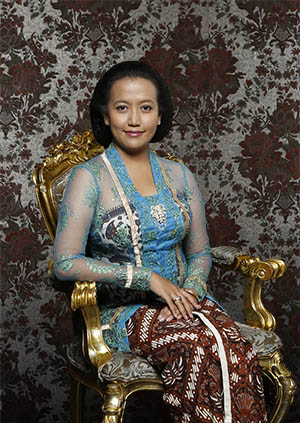
A kebaya is an upper garment traditionally worn by women in Southeast Asia, notably in Brunei, Indonesia, Malaysia, Singapore, and Southern Thailand. It is also worn in parts of southern Philippines and Cambodia.

Rumah Gadang or Rumah Bagonjong "house for the Minangkabau people" are the traditional homes of the Minangkabau in West Sumatra, Indonesia. The architecture, construction, internal and external decoration, and the functions of the house reflect the culture and values of the Minangkabau. A Rumah Gadang serves as a residence, a hall for family meetings, and for ceremonial activities. In the matrilineal Minangkabau society, the Rumah Gadang is owned by the women of the family who live there; ownership is passed from mother to daughter.
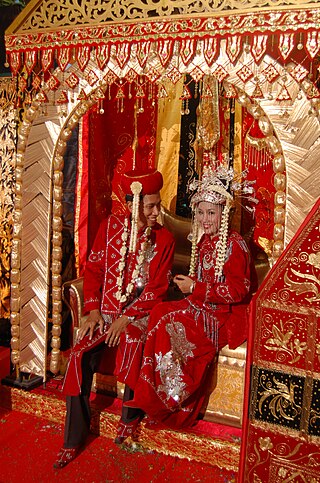
Betawi people, or Batavians, are an Austronesian ethnic group native to the city of Jakarta and its immediate outskirts, as such often described as the native inhabitants of the city. They are the descendants of the people who inhabited Batavia from the 17th century onwards.

The architecture of Indonesia reflects the diversity of cultural, historical, and geographic influences that have shaped Indonesia as a whole. Invaders, colonizers, missionaries, merchants, and traders brought cultural changes that had a profound effect on building styles and techniques.
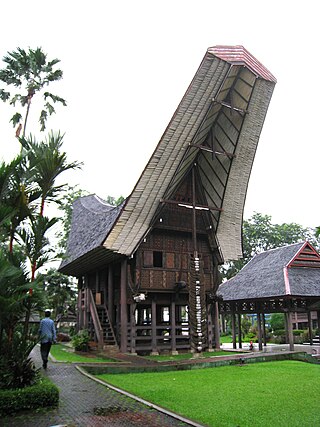
Tongkonan is the traditional ancestral house, or rumah adat, of the Torajan people in South Sulawesi, Indonesia. Tongkonan has a distinguishing boat-shaped and oversized saddleback roof. Like most of the Indonesia's Austronesian-based traditional architecture, tongkonan is built on piles. Its construction is a laborious task, and it is usually built with the help of all family members or friends. In the original Toraja society, only nobles had the right to build tongkonan. Commoners live in smaller and less decorated homes called banua.

Toba Batak people are the largest ethnic group of the Batak peoples of North Sumatra, Indonesia. The common phrase of ‘Batak’ usually refers to the Batak Toba people. This mistake is caused by the Toba people being the largest sub-group of the Batak ethnic and their differing social habit has been to self-identify as merely Batak instead of ‘Toba’ or ‘Batak Toba’, contrary to the habit of the Karo, Mandailing, Simalungun, Pakpak communities who commonly self-identify with their respective sub-groups.

Rumoh Aceh is a type of traditional vernacular house found in the Aceh Province in Indonesia. It is basically a wooden pile dwelling. Rumoh Aceh is the largest and tallest of all vernacular house types found in Aceh Province, the others are the Rumoh Santeut and the Rangkang.

Batak architecture refers to the related architectural traditions and designs of the various Batak peoples of North Sumatra, Indonesia. Six groups of Batak speak separate but related languages: the Angkola, the Mandailing to the south, the Toba, to the north the Pakpak/Dairi, the Simalungun, and the Karo. While the groups are now Muslim or Christian, elements of the ancient Batak religion remain, particularly amongst the Karo.

Rumah adat are traditional houses built in any of the vernacular architecture styles of Indonesia, collectively belonging to the Austronesian architecture. The traditional houses and settlements of the several hundreds ethnic groups of Indonesia are extremely varied and all have their own specific history. It is the Indonesian variants of the whole Austronesian architecture found all over places where Austronesian people inhabited from the Pacific to Madagascar each having their own history, culture and style.
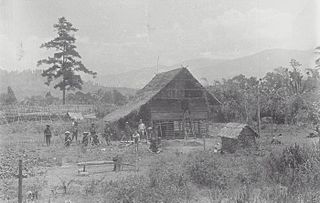
An uma is the traditional house of the Gajo district which borders Aceh on the Indonesian island of Sumatra.

The national costume of Indonesia is the national attire that represents the Republic of Indonesia. It is derived from Indonesian culture and Indonesian traditional textile traditions. Today the most widely recognized Indonesian national attires include batik and kebaya, although originally those attires mainly belong within the island of Java and Bali, most prominently within Javanese, Sundanese and Balinese culture. Since Java has been the political and population center of Indonesia, folk attire from the island has become elevated into national status.

Gorontalo people, also known as Gorontalese are a native ethnic group and the most populous ethnicity in the northern part of Sulawesi. The Gorontalo people have traditionally been concentrated in the provinces of Gorontalo, North Sulawesi, and the northern part of Central Sulawesi.

Rumah ulu is a vernacular house found in the highlands of South Sumatra, Indonesia. The house is associated with the Uluan people, who reside in the region upstream of the Ogan and Musi rivers.

A balairung is a village hall of the Minangkabau people of West Sumatra, Indonesia. It has a similar architectural form to the rumah gadang, the domestic architecture of the Minangkabau people. Whereas a rumah gadang is a proper building, the balairung is a pavilion-like structure used solely for holding a consensus decision-making process in the Minang society.
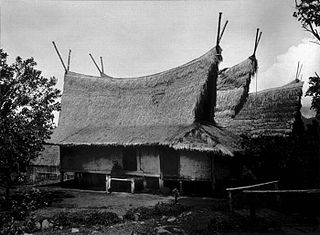
Sundanese traditional house refers to the traditional vernacular houses of the Sundanese people, who predominantly inhabited the western parts of Java island, Indonesia. The architecture of a Sundanese house is characterized by its functionality, simplicity, modesty, uniformity with a little detail, its use of natural thatched materials, and the quite faithful adherence to harmony with nature and the environment.

Minangkabau culture is the culture of the Minangkabau ethnic group in Indonesia, part of the Indonesian culture. This culture is one of the two major cultures in the Indonesian archipelago which is very prominent and influential.

The bodo blouse, locally known as baju bodo, is a sheer and transparent short-sleeved loose blouse, a traditional attire for women of the Bugis and Makassar peoples of South Sulawesi, Indonesia. A bodo blouse is traditionally combined with a matching woven sarong that covered the waist below the body.

The thousand legs house is the traditional house of the Arfak people who reside in Manokwari Regency, West Papua.




















